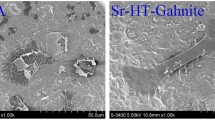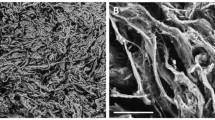Abstract
The development of bone replacement materials is an important objective in the field of orthopaedic surgery. Due to the drawbacks of treating bone defects with autografts, synthetic bone graft materials have become optional. So in this work, a bone tissue engineering approach with radiopaque bioactive strontium incorporated calcium phosphate was proposed for the preliminary cytocompatibility studies for bone substitutes. Accumulating evidence indicates that strontium containing biomaterials promote enhanced bone repair and radiopacity for easy imaging. Hence, strontium calcium phosphate (SrCaPO4) and hydroxyapatite scaffolds have been investigated for its ability to support and sustain the growth of rabbit adipose-derived mesenchymal stem cells (RADMSCs) in vitro. They were characterized via Micro-CT for pore size distribution. Cells used were isolated from New Zealand White rabbit adipose tissue, characterized by FACS and via differentiation into the osteogenic lineage by alkaline phosphatase, Masson’s trichome, Alizarin Red and von Kossa staining on day 28. Material-cell interaction was observed by SEM imaging of cell morphology on contact with material. Live–Dead analysis was done by confocal laser scanning microscopy and cell cluster analysis via μCT. The in vitro biodegradation, elution and nucleation of apatite formation of the material was evaluated using simulated body fluid and phosphate buffered saline in static regime up to 28 days at 37 °C. These results demonstrated that SrCaPO4 is a good candidate for bone tissue engineering applications and with osteogenically-induced RADMSCs, they may serve as potential implants for the repair of critical-sized bone defects.












Similar content being viewed by others
References
Langer R, Vacanti JP. Tissue engineering. Science. 1993;14:920–6.
Klara T, Csonge L, Janositz G, Csernatony Z, Lacaza. Albumin-coated structural lyophilized bone allografts: a clinical report of 10 cases. Cell Tissue Bank 2013 (in press).
Giannoudis PV, Einhorn TA, Marsh D. Fracture healing: the diamond concept. Injury. 2007;4:3–6.
Zuk PA, Zhu M, Mizuno H, Huang J, Futrell JW, Katz AJ, et al. Multilineage cells from human adipose tissue: implications for cell-based therapies. Tissue Eng. 2001;2:211–28.
Kakudo N, Shimotsuma A, Miyake S, Kushida S, Kusumoto K. Bone tissue engineering using human adipose-derived stem cells and honeycomb collagen scaffold. J Biomed Mater Res A. 2008;84:191–7.
Janicki P, Schmidmaier G. What should be the characteristics of the ideal bone graft substitute? Combining scaffolds with growth factors and/or stem cells. Injury. 2011;2:77–81.
Hench LL, Paschall HA. Direct chemical bond of bioactive glass-ceramic materials to bone and muscle. J Biomed Mater Res A. 1973;3:25–42.
Jarcho M, Kay JF, Gumaer KI, Doremus RH, Drobeck HP. Tissue, cellular and subcellular events at a bone-ceramic hydroxylapatite interface. J Bioeng. 1977;2:79–92.
Porter AE, Botelho CM, Lopes MA, Santos JD, Best SM, Bonfield W. Ultrastructural comparison of dissolution and apatite precipitation on hydroxyapatite and silicon-substituted hydroxyapatite in vitro and in vivo. J Biomed Mater Res A. 2004;69:670–9.
Buehler J, Chappuis P, Saffar JL, Tsouderos Y, Vignery A. Strontium ranelate inhibits bone resorption while maintaining bone formation in alveolar bone in monkeys (Macaca fascicularis). Bone. 2001;1:176–9.
Blake DGM, Zivanovic MA, McEwan AJ, Ackery DM. Sr-89 therapy: strontium kinetics in disseminated carcinoma of the prostate. Eur J Nucl Med. 1986;9:447–54.
Wong CT, Lu WW, Chan WK, Cheung KMC, Luk KDK, Lu DS, et al. In vivo cancellous bone remodeling on a strontium-containing hydroxyapatite (sr-HA) bioactive cement. J Biomed Mater Res A. 2004;68:513–21.
Yang F, Yang D, Tu J, Zheng Q, Cai L, Wang L. Strontium enhances osteogenic differentiation of mesenchymal stem cells and in vivo bone formation by activating Wnt/catenin signaling. Stem Cells. 2011;6:981–91.
Li Y, Li Q, Zhu S, Luo E, Li J, Feng G, et al. The effect of strontium-substituted hydroxyapatite coating on implant fixation in ovariectomized rats. Biomaterials. 2010;34:9006–14.
Zreiqat H, Ramaswamy Y, Wu C, Paschalidis A, Lu Z, James B, et al. The incorporation of strontium and zinc into a calcium–silicon ceramic for bone tissue engineering. Biomaterials. 2010;12:3175–84.
Gentleman E, Fredholm YC, Jell G, Lotfibakhshaiesh N, O’Donnell MD, Hill RG, et al. The effects of strontium-substituted bioactive glasses on osteoblasts and osteoclasts in vitro. Biomaterials. 2010;14:3949–56.
Park J-W, Kim H-K, Kim Y-J, Jang J-H, Song H, Hanawa T. Osteoblast response and osseointegration of a Ti–6Al–4V alloy implant incorporating strontium. Acta Biomater. 2010;7:2843–51.
Varma HK, Sivakumar R. Preparation and characterisation of free flowing hydroxyapatite powders. Phosphorous Res Bull. 1996;6:35–8.
Mohan BG, Shenoy SJ, Babu SS, Varma HK, John A. Strontium calcium phosphate for the repair of leporine (Oryctolagus cuniculus) ulna segmental defect. J Biomed Mater Res A. 2013;101:261–71.
Dorsey SM, Lin-Gibson S, Simon CG Jr. X-ray microcomputed tomography for the measurement of cell adhesion and proliferation in polymer scaffolds. Biomaterials. 2009;16:2967–74.
Guilak F. Volume and surface area measurement of viable chondrocytes in situ using geometric modelling of serial confocal sections. J Microsc. 1994;173:245–56.
Kokubo T, Kim H-M, Kawashita M. Novel bioactive materials with different mechanical properties. Biomaterials. 2003;13:2161–75.
Dahl SG, Allain P, Marie PJ, Mauras Y, Boivin G, Ammann P, et al. Incorporation and distribution of strontium in bone. Bone. 2001;4:446–53.
Canalis E, Hott M, Deloffre P, Tsouderos Y, Marie PJ. The divalent strontium salt S12911 enhances bone cell replication and bone formation in vitro. Bone. 1996;6:517–23.
Likins RC, Posner AS, Kunde ML, Craven DL. Comparative metabolism of calcium and strontium in the rat. Arch Biochem Biophys. 1959;83:472–81.
Hench LL, Wilson J. An introduction to bioactive ceramics. New york: World Scientific; 1993. p. 7.
Tsuruga E, Takita H, Itoh H, Wakisaka Y, Kuboki Y. Pore size of porous hydroxyapatite as the cell-substratum controls BMP-induced osteogenesis. J Biochem. 1997;121:317–24.
Dudas JR, Marra KG, Cooper GM, Penascino VM, Mooney MP, Jiang S, Rubin JP, et al. The osteogenic potential of adipose-derived stem cells for the repair of rabbit calvarial defects. Ann Plast Surg. 2006;56:543–8.
Zangi L, Rivkin R, Kassis I, Levdansky L, Marx G, Gorodetsky R. High-yield isolation, expansion, and differentiation of rat bone marrow-derived mesenchymal stem cells with fibrin microbeads. Tissue Eng. 2006;8:2343–54.
Mitchell JB, McIntosh K, Zvonic S, Garrett S, Floyd ZE, Kloster A, et al. Immunophenotype of human adipose-derived cells: temporal changes in stromal-associated and stem cell-associated markers. Stem Cells. 2006;2:376–85.
Zuk PA, Zhu M, Ashjian P, De Ugarte DA, Huang JI, Mizuno H, et al. Human adipose tissue is a source of multipotent stem cells. Mol Biol Cell. 2002;12:4279–95.
Tan W, Sendemir-Urkmez A, Fahrner LJ, Jamison R, Leckband D, Boppart SA. Structural and functional optical imaging of three-dimensional engineered tissue development. Tissue Eng. 2004;12:1747–56.
Ho ST, Hutmacher DW. A comparison of micro CT with other techniques used in the characterization of scaffolds. Biomaterials. 2006;8:1362–76.
Valentijn AJ, Zouq N, Gilmore AP. Anoikis. Biochem Soc Trans. 2004;32:421–5.
Marie PJ, Ammann P, Boivin G, Rey C. Mechanisms of action and therapeutic potential of strontium in bone. Calcif Tissue Int. 2001;69:121–9.
Zhang R, Ma PX. Poly(alpha-hydroxyl acids)/hydroxyapatite porous composites for bone-tissue engineering. I. Preparation and morphology. J Biomed Mater Res. 1999;44:446–55.
Acknowledgments
The authors acknowledge The Director SCTIMST and Head, BMT Wing for the facilities provided; DBT for financial assistance; UGC for the Senior Research Fellowship; Mr. Rana V Raj for isolating adipose tissue; Dr. Anil Kumar TV for confocal analysis, Mr. Nishad KV for technical support, Mr. Renjith P Nair for FACS analysis and Dental products laboratory for Micro-CT facility.
Author information
Authors and Affiliations
Corresponding author
Rights and permissions
About this article
Cite this article
Mohan, B.G., Suresh Babu, S., Varma, H.K. et al. In vitro evaluation of bioactive strontium-based ceramic with rabbit adipose-derived stem cells for bone tissue regeneration. J Mater Sci: Mater Med 24, 2831–2844 (2013). https://doi.org/10.1007/s10856-013-5018-y
Received:
Accepted:
Published:
Issue Date:
DOI: https://doi.org/10.1007/s10856-013-5018-y




